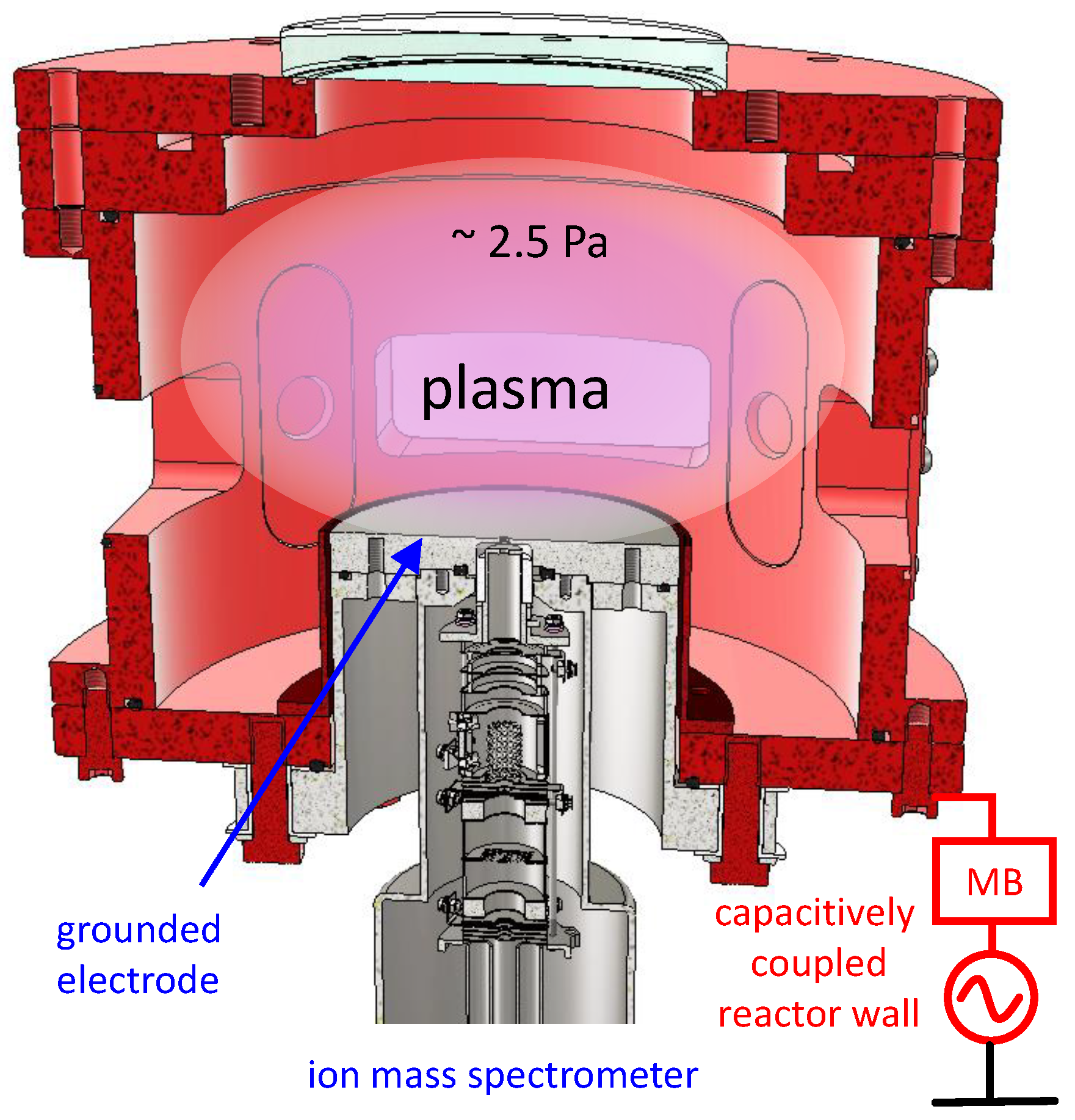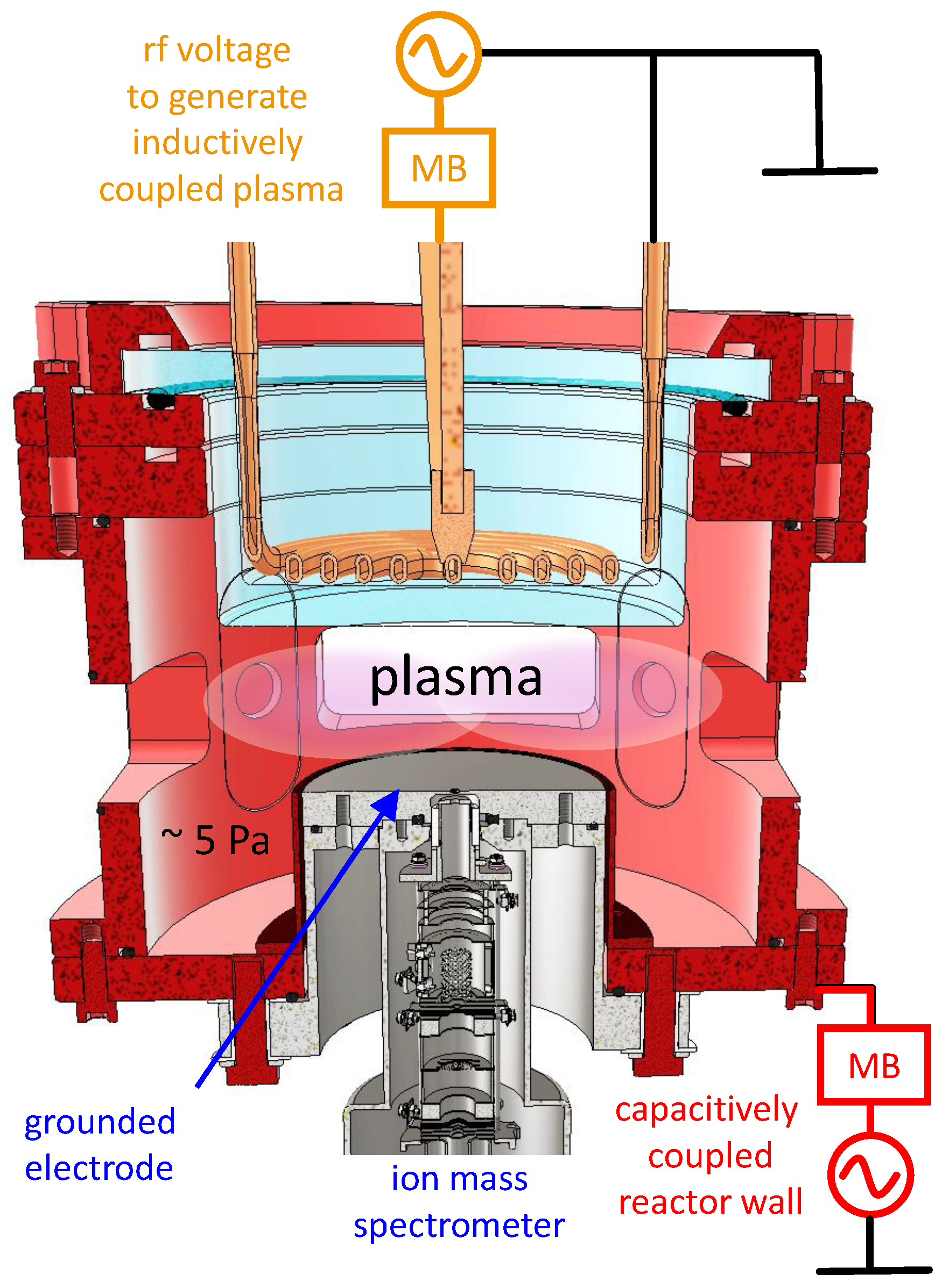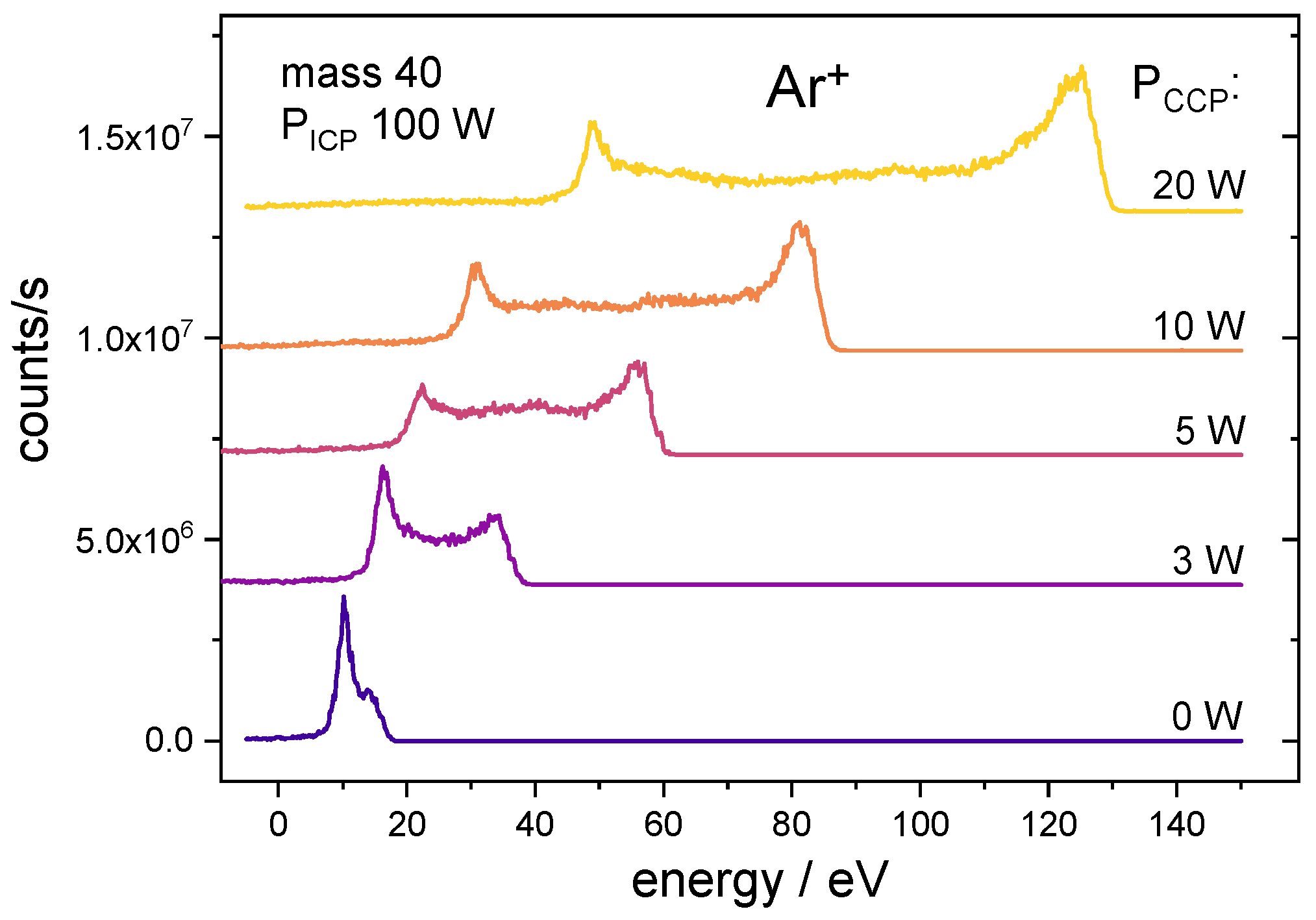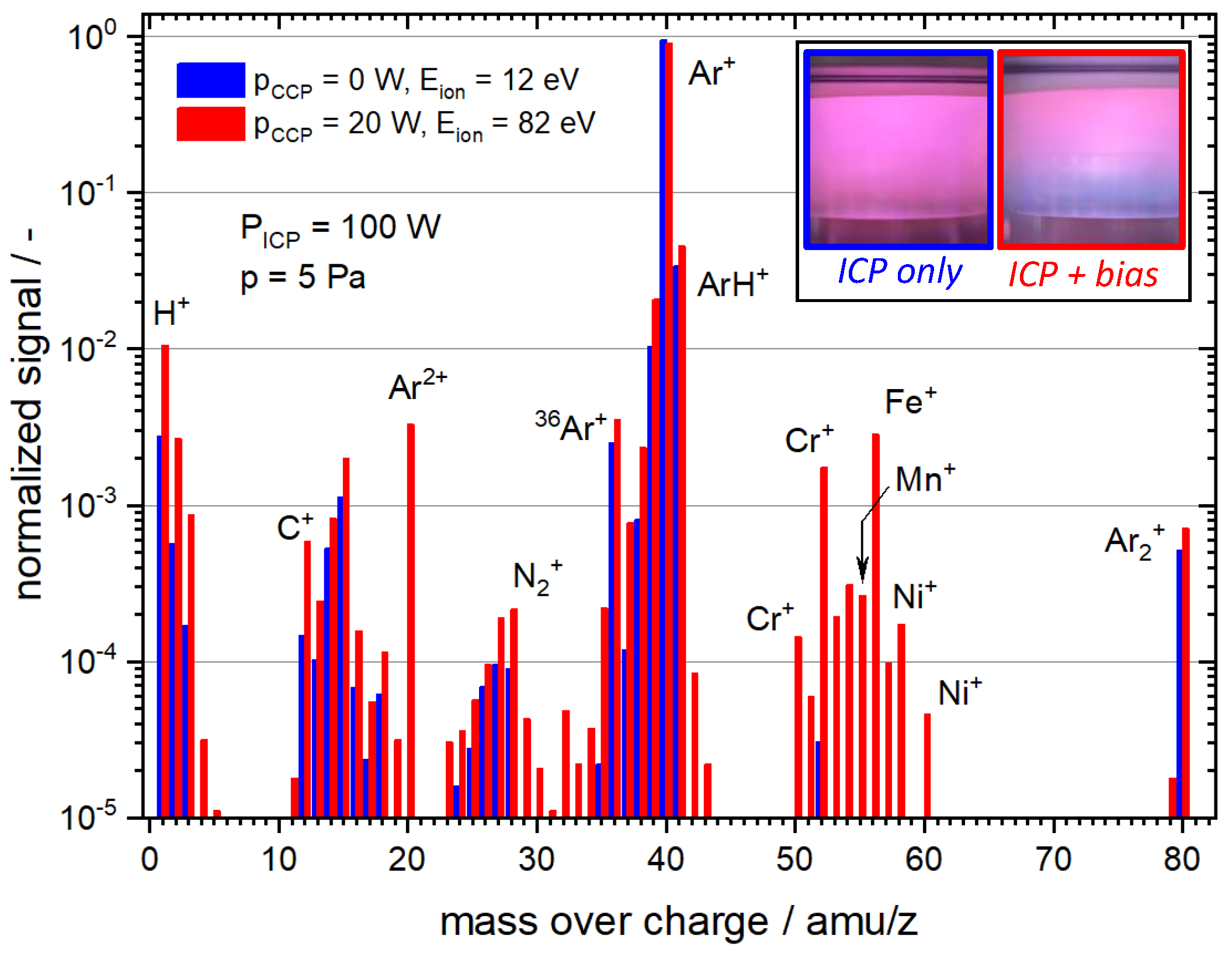3.1. Ion Analysis in an Ar CCP
The formation of different IEDFs for different ion species is exemplary shown for an Ar CCP at 300 V
and 2.5 Pa chamber pressure. To analyze the ion composition in the plasma, mass spectra have been measured at several ion energies to identify the dominant ions hitting the grounded electrode. Argon-related ions such as Ar
, Ar
, and ArH
were detected in addition to the dominant Ar
ion as well as low-density ions that are related to impurities such as H
, H
O
or N
. A typical mass spectrum is discussed in
Section 3.3 in more detail.
Figure 3 presents the IEDFs of the argon-related ions Ar
(20 amu), Ar
(40 amu), ArH
(41 amu), and Ar
(80 amu). Please note that ESMS distinguishes the ion’s mass-to-charge ratio (
in
) and energy-to-charge ratio (
in
). For example, doubly ionized argon (Ar
) appears at 20
in the mass spectrum and has twice the energy shown on the energy scale (Imagine it as two halves of the argon atoms moving together, each with elementary charge e
, mass 20 amu and the energy shown on the energy scale). Since all ions except Ar
are singly ionized, the term ion mass (
in amu) and ion energy (
in eV) is used throughout this work for convenience.
In low-pressure rf plasmas, the IEDF at the electrodes is a superposition of a bimodal peak structure around the time-averaged sheath potential [
3,
9,
10,
11] generated by ions traversing the sheath without collisions and a multiple peak structure at lower energies [
6,
7,
8,
12,
13,
14,
15] as a result of ion collisions in the sheath. The dominance of one of these structures is determined by the amount of decelerating ion-neutral collisions and, therefore, related to the ion collision cross section, the density of the collisional partners in the sheath, and the sheath width. In addition, ion formation due to electron impact ionization and dissociative recombination of molecular ions in the sheath might play a role but it is expected to be negligible due to the low electron density in the sheath. For most ions, the dominant ion neutral interaction is the resonant charge transfer collision or charge exchange collision (CXC) in which a fast ion collides with a slow neutral particle and transfers its charge to it resulting in fast neutrals and slow ions. CXC of ions with the neutral species of the same art is resonant with a large value of the CXC cross section. For an argon plasma:
Depending on the position in the sheath and phase of the rf voltage, at which these slow ions are generated, they are accelerated only in a fraction of the sheath potential and gain, therefore, less energy as they reach the substrate.
The bimodal peak structure result from ions that enter the sheath at different phases of the rf cycle. The separation of the two bimodal peaks is related to the ratio of the rf cycle duration
and ion transit time through the sheath
with the variation of the sheath potential during an rf cycle
[
16,
17,
18,
19,
20]. In our case of highly asymmetric electrode geometry, the sheath potential varies from a low floating potential (about 20 eV) to the rf peak-to-peak voltage plus the floating potential during an rf cycle, so
equals the peak-to-peak voltage. The ion transit time itself depends on sheath width
s, ion mass
and the time-averaged sheath potential
According to the above-mentioned variation of the sheath potential, the average sheath potential is about 20 eV higher than the rf amplitude, so in the case of
Figure 3 with 300 V
, at about 170 eV.
The IEDFs of Ar, ArH and Ar are dominated by ions traversing the sheath without collisions, and the bimodal peaks centered around the energy that corresponds to the ion acceleration in the time averaged-sheath potential are observed. This is the consequence of the low density of the neutral collision partners that are necessary for resonant CXC.
On the contrary, the IEDF of Ar
in
Figure 3 shows mainly peaks at lower energies from collisions in the sheath, whereas its bimodal peak structure is only a minor feature. These low-energy peaks originate in resonant CXC in the sheath [
7,
8,
13,
14,
15] as the cross section for Ar
-Ar resonant CXC is large [
21], the density of the collision partner (neutral Ar) is high, and the sheath width is also large due to the relatively low plasma density (large Debye length).
To demonstrate the influence of density on the number of collisions,
Figure 4 shows the IEDFs of Ar
ions for pressures between 1.25 Pa and 40 Pa. As the amount of collisions increases with pressure, the bimodal peak structure diminishes. Only the IEDFs for pressures below 5.0 Pa show a significant amount of collision-free ions from the bulk plasma.
3.2. Effect of Ar Gas Dilution with He
The large collision rate of Ar
ions in the sheath is determined both by the high argon atom density and the large CXC cross section. To reduce the effect of these resonant CXC collisions one has to lower the density (pressure) of the neutral argon atoms as demonstrated in the
Figure 4. However, the number of collisions can be effectively reduced by diluting Ar with He as well. Helium has very large ionization and excitation thresholds and the argon gas is, therefore, preferentially ionized in the plasma. Additionally, CXCs are not resonant for collisions of Ar
with He, and the formation of slow He
ions in their mutual collisions is prevented by the large ionization energy of helium atoms. Additionally, the momentum transfer in elastic collisions of Ar
with He atoms will be also small due to the large mass difference between both species.
Figure 5 shows the IEDFs of Ar
and He
ions as measured at a pressure of 2.5 Pa for several Ar/He gas mixtures. Additionally, the Ar
IEDF of an argon discharge from
Figure 3 is shown for comparison as well. In
Figure 5a, the 90% dilution of argon gas with helium (argon partial pressure of 0.25 Pa) clearly suppresses the collisional peaks in the IEDFs in favor of the bimodal peak structure as seen in the direct comparison with the IEDFs measured in pure argon. The He
ions appear as well with collisional IEDFs but with relatively low signal intensities compared to argon. It should be further noted that the ion transmission probability function of a typical quadrupole mass spectrometer scales with the ion mass to the power of
x, where
x is usually between −0.5 and −1, discriminating hence heavy ions against light ones [
22,
23,
24]. Taking this mass discrimination into account for He
and Ar
will result in the relative decrease of the signal intensities measured for He
with a factor between 3 and 10. Absolute energy resolved ion flux measurements with RFA could provide the correct value of the discrimination factor by comparing ESMS and RFA measurements performed in pure Ar and pure He. A further dilution to 96.4% He (argon partial pressure of 0.09 Pa) suppresses the collisional peaks in the Ar
IEDFs even further as shown in
Figure 5b. The intensity of the He
signal increases, but considering the previously discussed mass discrimination, the Ar
bimodal peak structure at around 180 eV will probably still dominate the ion flux to the grounded electrode.
For
Figure 5c, the Ar gas flow is switched off and only the leakage of the mass flow controller supplies an unknown but very low residual flow of Ar. The remaining Ar concentration is too low to still dominate the ion composition and the discharge is finally controlled by helium. Hence the ion flux to the surface is ruled by the collisional He
IEDF and the Ar
IEDF shows only a weak signal from the bimodal peak structure. Nevertheless, we showed that the dilution of the Ar working gas with He in the order of 90% to 95% He can significantly reduce the fraction of low energy Ar
ions and can realize conditions with a well-defined, almost monoenergetic Ar
IEDF also for the low ion fluxes of a CCP discharge. Such an IEDF is preferred since better control over the surface processes can be achieved.
The positive effect of Ar dilution with He is due to the large difference in the ionization energy between Ar (15.76 eV) and He (24.59 eV). Using a very small admixture of Kr or Xe gases with ionization energies of just 14.00 eV or 12.13 eV [
25] respectively, in place of Ar, would allow for even higher He dilutions with less flux of low energy He
ions due to the lower electron temperature needed for an effective ionization of Kr/Xe. Furthermore, according to (
1) and (
2), the energy spread of the bimodal peak structure
scales with
, so having ions with higher mass narrows this structure, making the IEDF more monoenergetic. Since only a very small fraction of the gas mixture consist of the expensive Kr or Xe gas, using He/Kr or He/Xe mixtures is a viable way in large-scale industrial applications, where precise ion treatment with a specific ion mass and narrow IEDFs are required.
3.3. Implementation of the Inductive Plasma Coupling
The combination of inductive and capacitive coupling of the rf power into the plasma is one possible solution enabling independent control of plasma density/ion flux and sheath voltage, where the high-density plasma is sustained by the inductive coupling with a rather low sheath potential, and the ion energy bombarding the surface is independently controlled by an additional dc self-bias formed by the capacitive coupling. This principle is used here, where the capacitive coupling is applied to the large area reactor wall resulting in a negative dc offset voltage on the small area grounded electrode. The ESMS integration of the grounded electrode as shown in the experimental setup in
Figure 2 is used to analyze the changes in the IEDFs.
When applying only the rf voltage to the rector wall, similar ions with similar IEDFs as in
Figure 3 are observed for an argon CCP at 5 Pa in
Figure 6a. The applied power of 20 W corresponds to lower plasma density and lower sheath voltage than previously used, resulting in both lower ion energies and lower measured signals. Applying only inductive coupling with the power of 100 W as shown in
Figure 6b results in large ion densities (large ion fluxes) with a single peak at an energy of about 12 eV corresponding to the ICP’s plasma potential. Please note that almost no Ar
ions are generated in a pure ICP as the maximum electron energies are low. In a CCP, secondary electrons can be accelerated in a high sheath potential to energies that easily exceed the second ionization energy of Ar (27.63 eV) [
25]. This is not the case in ICPs where the sheath potential is much lower (12 eV in our case). Applying both inductive and capacitive coupling results in high plasma densities and ion fluxes at high ion energies due to the additional rf bias as shown in
Figure 6c. In contrast to the low sheath potential in
Figure 6b, the high sheath potential can effectively accelerate secondary electrons to high energies which results in a comparably high density of Ar
ions. The higher plasma density also leads to a lower sheath width, which reduces the number of collisions in the sheath (the multiple peak structure at lower energies disappeared and the IEDF is dominated by the bimodal peak structure) and shorten significantly the ion transit time
(c.f. (
2)). The latter increases the energy spread of the bimodal peak structure
(c.f. (
1)) significantly. Ion treatments are less selective and less precise with such a broad bimodal peak structure. To narrow the bimodal peak structure under the conditions of high ion densities and low sheath width, the rf-bias frequency can be increased.
The CCP power controls the sheath voltage and is directly linked to the ion energy as demonstrated in
Figure 7. The measurements with the highest applied rf bias allow the detection and analysis of IEDFs not only for the argon ions but also for the ions of the sputtered material itself.
Figure 8 shows ion mass spectra for the ICP and the rf-biased ICP measured at the energy in the center of the bimodal peak structure (12 eV for the ICP, 82 eV for the rf-biased ICP). While the ion composition in the ICP consists, besides the Ar-related ions, only of ions from impurities (containing H, C, N, and O), the mass spectrum of the rf-biased ICP shows additional peaks due to ionized atoms sputtered from the stainless steel electrode. The application of the rf bias results in physical sputtering of the stainless steel electrode and the formation of metal ions such as Fe
, Cr
, Ni
, and Mn
. The accumulation of metal ions in the discharge is also observed in the change of the plasma emission close to the grounded electrode that becomes blue when the rf bias is applied as shown in the insets in
Figure 8. Even though sputtered metal ions are detectable in the ion flux, the sputtering damage to the electrode is negligible as the sputter rate is low for the typically used ion energies in the range of up to about 140 eV in this work. The sputtered material also coats the quartz cylinder, which shows a reflective but still semitransparent metal layer after several hours of operation. To ensure an unhindered rf field transmission, the cylinder is cleaned with nitric acid from time to time.
The combination of the rf-biased ICP with the inverted electrode geometry and the ESMS diagnostics allows us to study in great detail the effects of different ion species, ion fluxes and ion energies on a variety of substrates under realistic plasma treatment conditions, where, for example, sputtering of the substrate material can strongly influence the ion composition and plasma properties in general.














